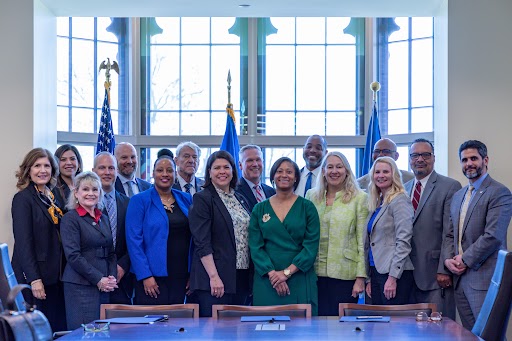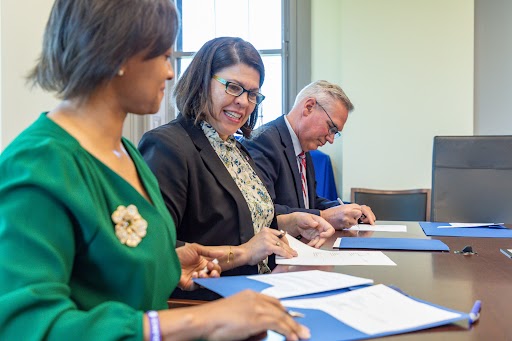GSA and DHS formalize partnership to promote sustainability
The General Services Administration and Department of Homeland Security will work together to make government operations more sustainable and resilient


WASHINGTON – Today, the U.S. General Services Administration (GSA) signed a memorandum of understanding (MOU) with the Department of Homeland Security (DHS) at the St. Elizabeths West Campus in Washington aimed at promoting decarbonization, clean and resilient technology, and high performance sustainable buildings.
The MOU is the first between GSA and another federal agency that focuses on achieving net-zero operations in support of DHS’ missions and the federal government’s goals. It aflso formalizes the longstanding partnership between the two agencies as they work together to reduce the environmental impact of government operations while increasing resilience to significant climate-driven events.
This partnership enables the agencies to share technical expertise, tools, and training to increase DHS and GSA facility sustainability and resilience, and spur deployment of clean energy technologies and infrastructure at the DHS headquarters at St. Elizabeths, as well as throughout DHS’ footprint nationwide.
The signing of this MOU underscores GSA’s commitment to establish and implement cross-cutting solutions that mitigate climate risks. As part of its Sustainability Plan [PDF], GSA is focused on improving energy, water and waste efficiency, reducing overall greenhouse gas emissions, and supporting the transition to carbon pollution-free electricity.
“GSA is excited to build on our close partnership with DHS as we both aim for net-zero emissions. This agreement is a roadmap for achieving sustainable and resilient buildings not only at St. Elizabeths campus, but also nationwide, so we can achieve a net-zero operational emission building portfolio by 2045,” said GSA’s Public Buildings Service Commissioner Nina Albert, who signed the MOU along with GSA’s Associate Administrator for Office of Government-wide Policy Krystal Brumfield and the Department of Homeland Security’s Chief Readiness Support Officer Tom Chaleki.
“There is great power in partnerships and leveraging resources for a focused goal,” said Chaleki. “Through this memorandum of understanding with GSA and DHS, we aim to strengthen our resilience, increase our sustainability, and reduce our energy consumption in our facilities owned and managed jointly by our Departments. These focused goals will employ strategies that support portfolio electrification and reductions in greenhouse gases.”
“We’re thrilled to be putting in place this MOU to build on our already strong collaboration,” added Brumfield. “Looking forward, GSA hopes to deepen relationships with other federal agencies across government as we all work to make the federal footprint more sustainable and resilient.”
President Biden has charged the U.S. federal government to lead by example by sustainably managing its footprint of over 300,000 buildings, over 600,000 vehicles, and $650 billion spent annually on goods and services. On Dec. 8, 2021, President Biden signed Executive Order 14057 and issued his Federal Sustainability Plan, which directs the Federal government to achieve net zero emissions by 2050 by transitioning federal infrastructure to zero-emission vehicles and energy efficient buildings, powered by carbon pollution-free electricity.
###
About GSA: GSA provides centralized procurement and shared services for the federal government, managing a nationwide real estate portfolio of nearly 370 million rentable square feet, overseeing approximately $75 billion in annual contracts, and delivering technology

 U.S. General Services Administration
U.S. General Services Administration